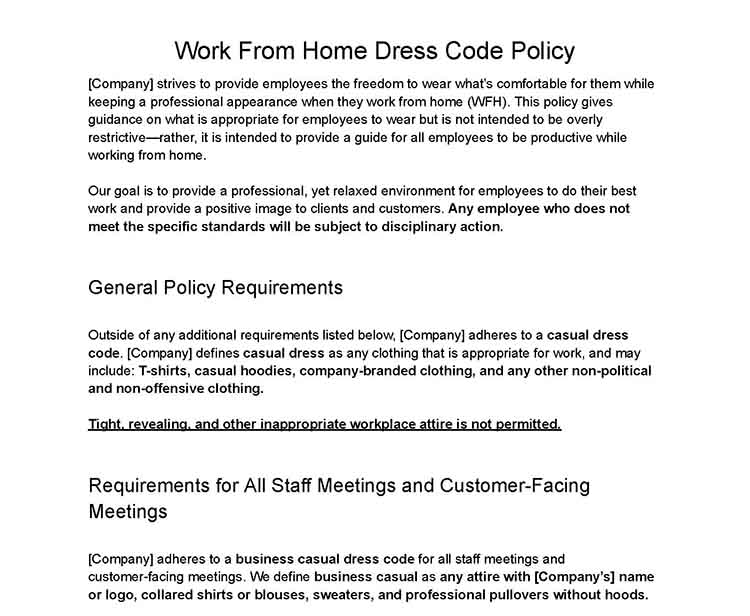A work from home (WFH) dress code policy standardizes the acceptable work attire for remote employees. Although it might seem irrelevant, you don’t want employees in their pajamas all day if they’re doing video calls with clients, prospects, and business leaders. Creating continuity and a level of professionalism keeps your team productive and focused, while protecting your brand, without compromising their freedom to wear what’s comfortable in their own home.
Here’s a work from home dress code policy you can download and modify to fit your needs.
Tips for Creating Your Work From Home Dress Code
Creating a WFH or remote work dress code may seem daunting, doesn’t have to be complicated. You can take your existing dress code and keep the same theme.
If your company has a formal dress code, maybe scale it back a bit and only require professional attire during company events or client meetings. If you already have a casual dress code, keep the same idea—but put some structure around it to make sure employees don’t show up in sweats every day. Ultimately, try to find a balance between professional and comfortable.
To guide you, here are a few things to keep in mind:
- Be specific. Don’t leave any ambiguity in your work from home dress code policy. Clearly define what you want employees to wear in different situations. If you say your work from home dress code is business casual, define it.
- Leave room for expression. While you need to be specific about what you expect employees to wear, don’t be overly restrictive. Don’t require that they wear a specific brand of shirt—unless your company is going to pay for them. Provide general guidelines and give employees freedom to move within them.
- Allow flexibility. Just like avoiding micromanagement is a great way to effectively manage your employees, giving your team space to wear what they like as long as it fits your remote work dress code is a way to show your employees you trust them.
- Be mindful of religious considerations. As an employer, you must accommodate reasonable religious requests, and if your WFH dress code does not accommodate employees and their religious needs relating to both attire and grooming, you could find yourself battling employee lawsuits and fines.
- Keep your remote dress code gender-neutral. Avoid gender-specific restrictions or regulations in your dress code. The Supreme Court recently ruled that Title VII of the Civil Rights Act of 1964 prohibits discrimination based on sexual orientation and gender identity. Make sure your dress code is gender-neutral in both text and application. Additional training for your managers may be necessary to make sure that the WFH dress code is applied evenly.
- Adhere to NLRA regulations. The National Labor Relations Act (NLRA) may also apply. If you have an employee wearing a political T-shirt on a video call, it might be protected speech. Some companies choose to include in their policy the prohibition of wearing clothes that express a political view—but those policies must be enforced consistently.
Examples
Click through the images below for options of what might be appropriate for your employees in different settings.
True Casual
Business Casual
Business Professional
Allowing for Seasonal Variations
In the world of remote work, the seasonality of attire becomes a unique consideration. It’s not just about comfort or temperature regulation; it’s about projecting professionalism and consistency, regardless of location or season.
Here’s how you can guide your team to adapt their work-from-home wardrobe to their respective climates.
Winter
For employees braving colder climates, winter demands warm, comfortable clothing. However, comfort should never eclipse professionalism. Encourage your team to opt for smart, cozy sweaters in deeper hues like navy, black, or forest green. Even in the cold, a well-groomed appearance on video calls is non-negotiable.
Spring
As the weather warms up, there might be a temptation to dress more casually. Guide your team to transition smoothly with lighter fabrics and brighter colors, without losing the professional edge. Swapping winter sweaters for crisp shirts or blouses can strike the right balance.
Summer
Summer can often blur the lines between vacation and work attire. Emphasize to your team that, despite the heat, professionalism remains key. Recommend lightweight, breathable fabrics in light colors. Beachwear or tank tops have no place in the remote work environment.
Autumn
Autumn is a season of change, and your team’s attire should reflect that. As temperatures drop, layering becomes important. A cardigan in a neutral tone over a professional shirt or blouse can combine comfort and professionalism perfectly.
What About Simply Having an ‘Appropriate’ Dress Code?
The concept of appropriate attire has evolved. More and more businesses are leaning towards a lax dress code policy, allowing employees to determine what’s appropriate for their work-from-home scenario. But what does this mean in practice?
In a traditional office setting, “appropriate” often translates to formal or business casual attire. However, in a remote work environment, the lines can blur. Appropriateness becomes less about formality and more about maintaining a professional image during work-related interactions. It’s about choosing clothing that lets you perform your duties effectively and represent your company positively.
Pros and Cons of a Lax Approach
Embracing a lax dress code policy comes with its own set of pros and cons.
| PROS | CONS |
|---|---|
| Employee Comfort: Comfortable employees are often happier and more productive, focusing on their work instead of worrying about their attire. | Blurred Lines: Without clear guidelines, the line between casual and too casual can easily blur, potentially harming your company's image. |
| Individual Expression: A relaxed dress code allows employees to express their personal style, fostering creativity and individuality, while still ensuring you avoid political or inappropriate attire. | Inconsistency: A lenient approach could lead to inconsistency in how employees present themselves, which might reflect poorly during client interactions. |
| Reduced Pressure: It eases the pressure on employees to maintain a formal appearance, especially when working from home. | Decreased Productivity: For some, dressing too casually could lead to a more relaxed attitude toward work, impacting productivity levels. |
So, where does this leave us? Striking a balance is key. For some companies, having a more lenient dress code that allows employees to dress appropriately—whatever they deem that to be—could work, especially when workers spend little or no time interacting with clients and customers. However, in businesses where client-facing work is more frequent, avoid this type of dress code as it can lead to inconsistent customer experiences.
Enforcing a Remote Work Dress Code
Enforcing a work from home dress code policy doesn’t have to be hard. A key people management skill is getting employees to understand your policies and why they matter.
Here’s how you can enforce your dress code in a professional way.
- Show respect. Don’t tell an employee in front of their colleagues that their clothes are inappropriate. Have a private call with the individual to discuss their attire, keeping your discussion confidential.
- Provide specific examples. Be prepared to give the employee specific examples of a dress code violation. This is why it’s crucial that your WFH dress code policy has clear guidelines.
- Reinforce the importance. Many employees may wonder why you need a work from home dress code at all. Communicate to your employees the need to have professional attire in certain settings and explain the benefits to them and their productivity.
What to Do With Repeated WFH Dress Code Policy Noncompliance
Violations of your WFH dress code policy can happen. Handling these infractions effectively and fairly requires adherence to a progressive discipline policy.
The goal of a progressive discipline policy isn’t to punish, but to correct behavior. Each incident should be handled with fairness, consistency, and transparency, ensuring the employee understands why their attire was deemed inappropriate.
Importance of a WFH Dress Code for Small Businesses
Many employees working from home prioritize comfort over business attire. Even if you have some employees come into an office some of the time, according to The Hill, workers who are comfortable being remote are more likely to wear more casual attire.
It’s clear that without a formal remote work dress code policy employees will wear whatever they want. However, by implementing a work from home dress code, even a casual one, you may find increased productivity, better camaraderie, and a difference in the psychological approach your employees bring to work.
Productivity
Remote employees often work harder and longer, leading to higher levels of productivity. Interestingly, these employees are also rarely late to work, ensuring punctuality and better time management.
Camaraderie
By creating a work from home dress code that puts barriers around what’s acceptable and unacceptable to wear, you eliminate drastic differences between employees where one employee on a video call may be dressed in a professional suit and another in a hoodie. When employees can count on their colleagues to be dressed in a similar fashion, it creates a sense of camaraderie within your team and a feeling of equal footing.
Costs
The benefits of having a flexible work from home dress code can include reduced costs for your employees. While we don’t advocate for obliterating a dress code, we do suggest a more inclusive dress code that allows employees to wear what’s already in their closets. This saves them money and earns your company goodwill.
Check out our latest article on remote work statistics.
Legal Considerations for WFH Dress Code Policies
Navigating the legal landscape surrounding dress code policies can seem overwhelming but, with the right knowledge, you can effectively prepare. In this section, we will discuss three key aspects: accommodations for religious or cultural needs, uniform enforcement, and the importance of regular policy reviews.
Accommodations for Religious and Cultural Needs
In an increasingly diverse workforce, it’s essential to consider religious and cultural needs when crafting your work from home dress code policy. The law requires employers to provide reasonable accommodations for employees’ sincerely held religious beliefs or practices, unless doing so would cause undue hardship.
What constitutes a reasonable accommodation? Let’s consider some examples:
- An employee who wears a hijab, yarmulke, or cross as part of their religious practice should be allowed to do so, provided it does not interfere with their duties.
- If an employee’s religion requires them to wear certain attire that falls outside the established dress code, modifying the policy for that individual could be seen as a reasonable accommodation.
However, not all accommodations are considered reasonable. If an accommodation poses an undue hardship to the business—for example, compromising safety standards or causing significant disruption to operations—it may not be required.
Uniform Enforcement
The golden rule of any policy enforcement is fairness. Each employee, regardless of position or seniority, should be subject to the same dress code requirements. Inconsistent enforcement can lead to claims of discrimination, which can result in legal complications.
To ensure uniform enforcement, train your managers and HR representatives on the policy and its enforcement procedures. Keep records of any violations and the steps taken to address them. This not only ensures consistency but also provides documentation should any legal issues arise.
The Importance of Regular Reviews
Your dress code policy isn’t a set-it-and-forget-it document. It should be reviewed at least annually and updated as necessary. Changes in fashion trends, cultural norms, or legal requirements could necessitate revisions. Regular reviews also provide an opportunity to address any concerns or issues that have arisen over the past year.
Your business is dynamic, and your dress code policy should reflect that. It’s not a static document but a living, evolving set of guidelines that adapts to your business needs and respects the diversity of your workforce.
Bottom Line
Working from home and working remotely has been around for many years, but became much more widespread during the COVID-19 pandemic. According to MIT, government data shows at least 27% of the American workforce is remote, while some private studies suggest that number is closer to half. Either way, this is not a trend that will reverse course.
Setting clear guidelines is crucial to ensuring your team meets your expectations—and that logic also applies to a remote work dress code policy. Especially when dealing with clients or customers, you want to project a professional image. Your company’s work from home dress code policy will help your employees know how to dress in each situation.









